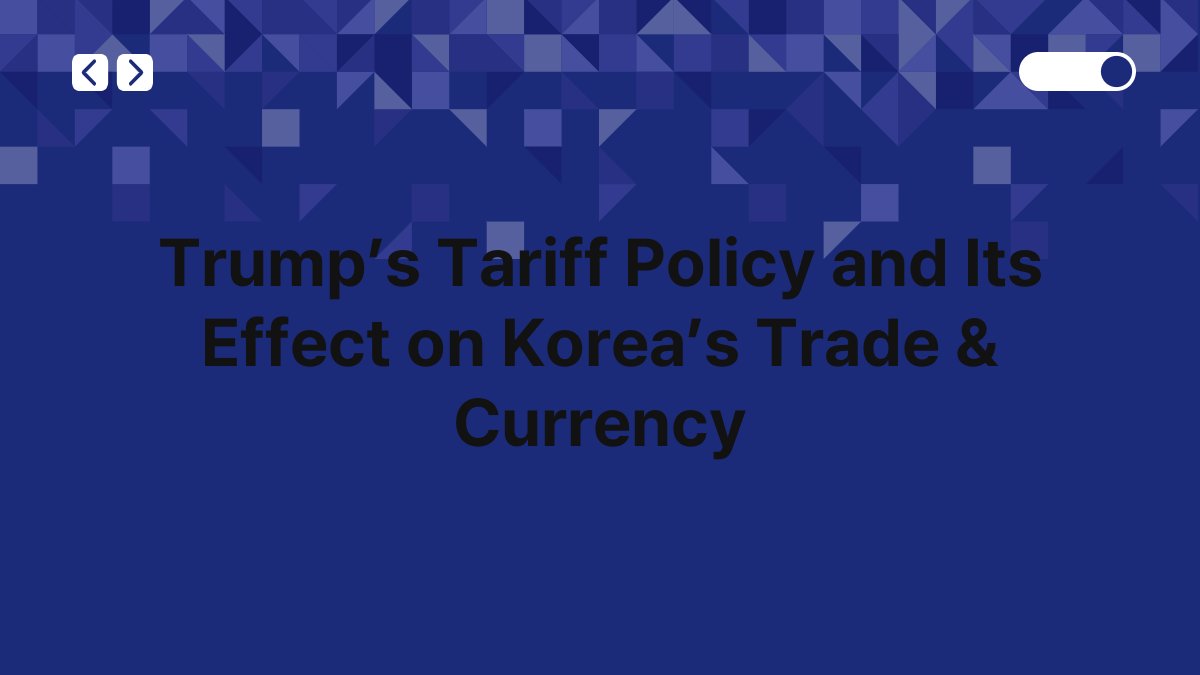[K-Bridge/Samuel] Trump’s Tariff Policy and Its Effect on Korea’s Trade & Currency represents a significant shift in international trade dynamics.
Under the Trump administration, tariffs were imposed on various goods, particularly targeting countries like China, which in turn affected global supply chains.
The repercussions of these policies extended beyond the United States, influencing trade relationships and currency valuations in countries such as South Korea.
Understanding the implications of these tariffs is crucial for grasping the broader economic landscape and the strategic decisions made by both governments and businesses.
This article will provide insights into the mechanisms of Trump’s tariff policy, its direct effects on Korea’s trade, the implications for the South Korean currency, and potential future scenarios for trade relations.
Readers will gain a comprehensive understanding of the interconnectedness of global trade and currency markets, as well as the strategic responses from South Korea.
The Basics of Trump’s Tariff Policy
Overview of Tariff Implementation
Trump’s tariff policy was primarily characterized by the imposition of tariffs on steel and aluminum imports, along with additional tariffs on numerous Chinese products.
These tariffs were justified as measures to protect American industries from foreign competition.
The administration argued that such protectionism would lead to job creation and economic growth in the United States.
However, the approach sparked significant backlash from various sectors, leading to retaliatory measures from affected countries.
Objectives Behind the Policy
The main objectives of Trump’s tariff policy included reducing the trade deficit with countries like China and revitalizing American manufacturing.
By imposing tariffs, the administration aimed to encourage domestic production and discourage reliance on foreign goods.
This approach was rooted in a broader nationalist economic agenda, which prioritized American interests over global trade agreements.
Impact on Global Trade Relations
The implementation of these tariffs not only affected U.S.
trade partners but also disrupted established global supply chains.
Countries reliant on exports to the U.S.
faced challenges in maintaining their trade volumes, leading to a reevaluation of their economic strategies.
The resulting tensions prompted discussions on trade agreements and alliances, as nations sought to mitigate the adverse effects of unilateral tariff actions.
Effects on Korea’s Trade Balance
Changes in Export Dynamics
South Korea, as a significant trading partner of the United States, experienced notable changes in its export dynamics due to Trump’s tariff policy.
Tariffs on steel and aluminum impacted South Korean manufacturers, particularly those in the automotive and electronics sectors, which rely on these materials.
The increased costs associated with tariffs led to price adjustments and a reevaluation of supply sources.
Retaliation and Trade Adjustments
In response to U.S.
tariffs, South Korea implemented its own measures, targeting U.S.
agricultural products and other goods.
This retaliation aimed to protect local industries and mitigate the economic impact of U.S. policies.
South Korean exporters had to navigate a more complex trade environment, leading to shifts in market strategies and the exploration of new markets.
Long-term Trade Strategy Reevaluation
The long-term implications of Trump’s tariff policy forced South Korea to rethink its trade strategy.
With the uncertainty surrounding U.S.
trade policies, South Korean businesses began diversifying their export markets and reducing dependence on the U.S.
economy.
This shift not only aimed to stabilize trade volumes but also to enhance resilience against future tariff-related disruptions.
Currency Valuation and Economic Impact
Fluctuations in the Korean Won
Trump’s tariff policy contributed to fluctuations in the value of the South Korean won.
As trade tensions escalated, investor sentiment wavered, leading to volatility in currency markets.
The won often reacted to news regarding U.S.-China trade relations, reflecting broader concerns about global economic stability.
Impact on Inflation and Consumer Prices
The imposition of tariffs also had implications for inflation and consumer prices in South Korea.
Increased costs for imported goods, particularly those affected by tariffs, translated into higher prices for consumers.
This inflationary pressure raised concerns among policymakers, prompting discussions on monetary policy adjustments to mitigate adverse effects.
Strategic Currency Management
In response to currency fluctuations, the Bank of Korea had to adopt a strategic approach to currency management.
By monitoring global economic indicators and trade relations, the central bank aimed to stabilize the won and ensure economic stability.
This proactive stance was essential in maintaining investor confidence and supporting South Korea’s economic growth.
South Korea’s Response Strategies
Diversification of Trade Partners
In light of the challenges posed by Trump’s tariff policy, South Korea pursued diversification of its trade partners.
By strengthening economic ties with Southeast Asian nations and other emerging markets, South Korea aimed to reduce its reliance on the U.S.
and China.
This strategic pivot not only mitigated risks associated with tariff fluctuations but also opened new avenues for growth.
Strengthening Domestic Industries
The South Korean government implemented measures to bolster domestic industries affected by tariffs.
By providing support for research and development, as well as financial assistance to vulnerable sectors, the government sought to enhance competitiveness.
This focus on strengthening local industries aimed to create a more resilient economic framework capable of withstanding external pressures.
Enhancing Trade Agreements
South Korea actively engaged in enhancing existing trade agreements and negotiating new ones to counterbalance the effects of U.S.
tariffs.
By fostering closer ties with countries in the Asia-Pacific region and beyond, South Korea aimed to create a more favorable trade environment.
Strengthening multilateral agreements was seen as a crucial step toward ensuring long-term economic stability.
The Role of International Trade Agreements
Impact of Existing Agreements
The effects of Trump’s tariff policy highlighted the importance of existing international trade agreements for South Korea.
Agreements such as the Korea-U.S.
Free Trade Agreement (KORUS) played a critical role in shaping trade dynamics.
While tariffs introduced challenges, these agreements provided a framework for negotiations and dispute resolution.
Pursuit of New Agreements
In response to the changing trade landscape, South Korea actively pursued new trade agreements to strengthen its global position.
The Comprehensive and Progressive Agreement for Trans-Pacific Partnership (CPTPP) emerged as a focal point for South Korea’s trade strategy.
By joining or enhancing participation in such agreements, South Korea aimed to secure favorable trade conditions and mitigate the impact of unilateral tariffs.
Multilateral Cooperation
South Korea recognized the value of multilateral cooperation in addressing the challenges posed by Trump’s tariff policy.
By engaging with international organizations and participating in trade forums, South Korea sought to promote a rules-based trading system.
This collaborative approach aimed to foster dialogue and reduce tensions in global trade relations.
Future Scenarios in Trade Relations
Potential for Continued Tariff Policies
The potential for continued tariff policies under future administrations remains a critical concern for South Korea.
Uncertainty surrounding U.S.
trade policies necessitates ongoing vigilance and adaptability in South Korea’s economic strategy.
Businesses must prepare for various scenarios, including the possibility of further tariffs or trade negotiations that could reshape the landscape.
Long-term Economic Implications
The long-term economic implications of Trump’s tariff policy will continue to influence South Korea’s trade relations and currency valuation.
Businesses must navigate a complex environment characterized by shifting trade dynamics and evolving consumer preferences.
Strategic planning and risk management will be essential for maintaining competitiveness in this uncertain landscape.
Emphasis on Resilience and Adaptability
In response to the challenges presented by Trump’s tariff policy, South Korea is likely to emphasize resilience and adaptability in its economic strategy.
By fostering innovation, investing in technology, and enhancing workforce skills, South Korea can position itself to thrive in a rapidly changing global economy.
This proactive approach will be crucial for navigating future trade challenges and ensuring sustained economic growth.
Conclusion: Lessons Learned from Tariff Policies
Understanding Global Interconnectedness
Trump’s tariff policy serves as a reminder of the interconnectedness of global trade and the far-reaching consequences of unilateral actions.
Countries like South Korea must remain aware of the complexities of international trade dynamics and the potential impacts on their economies.
The lessons learned from this experience will shape future trade strategies and policies.
Importance of Strategic Planning
The challenges posed by tariffs underscore the importance of strategic planning for businesses and governments alike.
By anticipating potential disruptions and developing contingency plans, stakeholders can better navigate the uncertainties of global trade.
This proactive stance will be essential in fostering a resilient economic environment.
The Future of Trade Relations
Looking ahead, the future of trade relations will depend on the ability of countries to engage in constructive dialogue and cooperation.
Navigating the complexities of international trade requires a collaborative approach that prioritizes mutual benefits.
By fostering strong partnerships and embracing innovation, countries can work towards a more stable and prosperous global economy.








